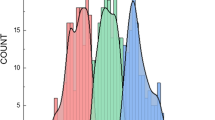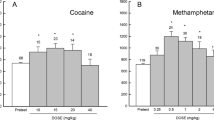Abstract
Rationale
The place conditioning procedure is increasingly used to study relapse in drug seeking in mice. However, the retention course of drug-induced place preference has not been systematically characterized.
Methods
The effects of cocaine doses and number of conditioning trials on both the magnitude and the persistence of cocaine-induced conditioned place preference (CPP) were investigated in C57BL/6J mice. Twelve groups of animals were injected with saline, 4, 8 or 12 mg/kg cocaine (i.p.) and submitted to an unbiased counterbalanced place conditioning protocol including one, two or four drug-pairing sessions. Subsequently, the animals were tested at various time intervals after the last conditioning session.
Results
One cocaine-pairing session was insufficient to induce a CPP. Two and four pairing sessions resulted in significant place preferences of similar magnitude for all tested doses of cocaine, the place preference induced by the greatest number of pairing sessions being the strongest. In the two-pairing groups, place preference lasted less than 14 days for any tested dose of cocaine. In contrast, all four-pairing groups still showed significant place preference 28 days after the last conditioning session. However, the magnitude of cocaine place preference slowly declined at a rate that was dependent upon cocaine dose. On the 35-day post-conditioning interval, only the 12-mg/kg cocaine group still displayed a significant place preference, whereas place preference was undetectable at 42 and 56 days post-conditioning for all groups.
Conclusions
The number of cocaine-pairing sessions, but not cocaine dose, affected the magnitude of cocaine place preference in mice when tested 1 day after the last conditioning session. In contrast, both cocaine doses and the number of pairing sessions affected the persistence of cocaine place preference. Overall, these results demonstrate that cocaine-induced place preference is a long lasting phenomenon that is strongly affected by the number of drug-pairing trials.




Similar content being viewed by others
References
Anderson JR (2000) Learning and memory, 2nd edn. Wiley, New York
Bardo MT, Neisewander JL, Miller JS (1986) Repeated testing attenuates conditioned place preference with cocaine. Psychopharmacology 89:239–243
Bardo MT, Rowlett JK, Harris MJ (1995) Conditioned place preference using opiate and stimulant drugs: a meta-analysis. Neurosci Biobehav Rev 19:39–51
Becker A, Grecksch G, Kraus J, Loh HH, Schroeder H, Hollt V (2002) Rewarding effects of ethanol and cocaine in mu opioid receptor-deficient mice. Naunyn-Schmiedeberg’s Arch Pharmacol 365:296–302
Bucherelli C, Tassoni G (1992) Duration of retrograde amnesia induced by tetrodotoxin inactivation of the parabrachial nuclei is inversely related to the intensity of footshock in rat’s passive avoidance response. Behav Brain Res 49:175–180
Cervo L, Samanin R (1995) Effects of dopaminergic and glutamatergic receptor antagonists on the acquisition and expression of cocaine conditioning place preference. Brain Res 673:242–250
Cervo L, Mukherjee S, Bertaglia A, Samanin R (1997) Protein kinases A and C are involved in the mechanisms underlying consolidation of cocaine place conditioning. Brain Res 775:30–36
Ciccocioppo R, Martin-Fardon R, Weiss F (2004) Stimuli associated with a single cocaine experience elicit long-lasting cocaine-seeking. Nat Neurosci 7:495–496
Cunningham CL, Dickinson SD, Grahame NJ, Okorn DM, McMullin CS (1999) Genetic differences in cocaine-induced conditioned place preference in mice depend on conditioning trial duration. Psychopharmacology 146:73–80
Fudala PJ, Iwamoto ET (1986) Further studies on nicotine-induced conditioned place preference in the rat. Pharmacol Biochem Behav 25:1041–1049
Gong W, Neill DB, Justice JB Jr (1995) Increased sensitivity to cocaine place-preference conditioning by septal lesions in rats. Brain Res 683:221–227
Grimm JW, Hope BT, Wise RA, Shaham Y (2001) Incubation of cocaine craving after with withdrawal. Nature 412:141–142
Hall FS, Drgonova J, Goeb M, Uhl GR (2003) Reduced behavioral effects of cocaine in heterozygous brain-derived neurotrophic factor (BDNF) knockout mice. Neuropsychopharmacology 28:1485–1490
Itzhak Y, Martin JL (2000) Scopolamine inhibits cocaine-conditioned but not unconditioned stimulant effects in mice. Psychopharmacology 152:216–223
Jacobs EH, Smit AB, de Vries TJ, Schoffelmeer AN (2003) Neuroadaptative effects of active versus passive drug administration in addiction research. Trends Pharmacol Sci 24:566–573
Le Pen G, Duterte-Boucher D, Costentin J (1996) Place conditioning with cocaine and the dopamine uptake inhibitor GBR12783. NeuroReport 7:2839–2842
Lepore M, Vorel SR, Lowinson J, Gardner EL (1995) Conditioned place preference induced by delta 9-tetrahydrocannabinol: comparison with cocaine, morphine, and food reward. Life Sci 56:2073–2080
McNamara RK, Namgung U, Routtenberg A (1996) Distinctions between hippocampus of mouse and rat: protein F1/GAP-43 gene expression, promoter activity, and spatial memory. Brain Res Mol Brain Res 40:177–187
Miner LL (1997) Cocaine reward and locomotor activity in C57BL/6J and 129/SvJ inbred mice and their F1 cross. Pharmacol Biochem Behav 58:25–30
Mucha RF, Iversen SD (1984) Reinforcing properties of morphine and naloxone revealed by conditioned place preferences: a procedural examination. Psychopharmacology 82:241–247
Mueller D, Stewart J (2000) Cocaine-induced conditioned place preference: reinstatement by priming injections of cocaine after extinction. Behav Brain Res 115:39–47
Mueller D, Perdikaris D, Stewart J (2002) Persistence and drug-induced reinstatement of a morphine-induced conditioned place preference. Behav Brain Res 136:389–397
Nomikos GG, Spyraki C (1988) Cocaine-induced place conditioning: importance of route of administration and other procedural variables. Psychopharmacology (Berl) 94:119–125
Parker LA, McDonald RV (2000) Reinstatement of both a conditioned place preference and a conditioned place aversion with drug primes. Pharmacol Biochem Behav 66(3):559–561
Russo SJ, Jenab S, Fabian SJ, Festa ED, Kemen LM, Quinones-Jenab V (2003) Sex differences in the conditioned rewarding effects of cocaine. Brain Res 970:214–220
Sanchez CJ, Bailie TM, Wu WR, Li N, Sorg BA (2003) Manipulation of dopamine d1-like receptor activation in the rat medial prefrontal cortex alters stress- and cocaine-induced reinstatement of conditioned place preference behavior. Neuroscience 119:497–505
Sara SJ (2000) Retrieval and reconsolidation: toward a neurobiology of remembering. Learn Mem 7:73–84
Schroeder JP, Packard MG (2003) Systemic or intra-amygdala injections of glucose facilitate memory consolidation for extinction of drug-induced conditioned reward. Eur J Neurosci 17:1482–1488
Seale TW, Carney JM (1991) Genetic determinants of susceptibility to the rewarding and other behavioral actions of cocaine. J Addict Dis 10:141–162
Sora I, Wichems C, Takahashi N, Li XF, Zeng Z, Revay R, Lesch KP, Murphy DL, Uhl GR (1998) Cocaine reward models: conditioned place preference can be established in dopamine- and in serotonin-transporter knockout mice. Proc Natl Acad Sci U S A 95:7699–7704
Spear NE (1978) The processing of memories: forgetting and retention. Erlbaum, Hillsdale, NJ
Spyraki C, Fibiger HC, Phillips AG (1982) Cocaine-induced place preference conditioning: lack of effects of neuroleptics and 6-hydroxydopamine lesions. Brain Res 253:195–203
Szumlinski KK, Price KL, Frys KA, Middaugh LD (2002) Unconditioned and conditioned factors contribute to the ‘reinstatement’ of cocaine place conditioning following extinction in C57BL/6 mice. Behav Brain Res 136:151–160
Tzschentke TM (1998) Measuring reward with the conditioned place preference paradigm: a comprehensive review of drug effects, recent progress and new issues. Prog Neurobiol 56:613–672
Tzschentke TM, Schmidt WJ (1995) N-Methyl-d-aspartic acid-receptor antagonists block morphine-induced conditioned place preference in rats. Neurosci Lett 193:37–40
White NM (1996) Addictive drugs as reinforcers: multiple partial actions on memory systems. Addictions 91:921–949
Zhang Y, Mantsch JR, Schlussman SD, Ho A, Kreek MJ (2002) Conditioned place preference after single doses or “binge” cocaine in C57BL/6J and 129/J mice. Pharmacol Biochem Behav 73 :655–662
Zigmond MJ, Bloom FE, Landis SC, Roberts JL, Squire LR (1999) Fundamental neuroscience. Academic Press, San Diego
Acknowledgements
The present research was supported by the Belgian National Foundation for Scientific Research (FNRS), grant F.R.F.C. No. 2.4533.02F to Ezio Tirelli.
Author information
Authors and Affiliations
Corresponding author
Rights and permissions
About this article
Cite this article
Brabant, C., Quertemont, E. & Tirelli, E. Influence of the dose and the number of drug-context pairings on the magnitude and the long-lasting retention of cocaine-induced conditioned place preference in C57BL/6J mice. Psychopharmacology 180, 33–40 (2005). https://doi.org/10.1007/s00213-004-2138-6
Received:
Accepted:
Published:
Issue Date:
DOI: https://doi.org/10.1007/s00213-004-2138-6




